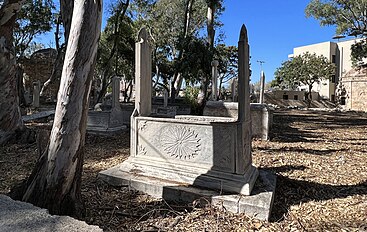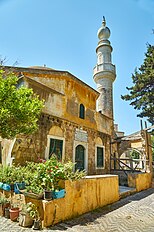Murat Reis Mosque
The Murat Reis Mosque (Greek: Τζαμί Μουράτ Ρέις, from Turkish: Murat Reis Camii) is a historical Ottoman-era mosque in the Aegean island of Rhodes, in Greece. Named in honour of Murat Reis the Elder, an important admiral of the Ottoman Navy, the mosque still stands, it is in need of restoration and is not open for worship, similar to the majority of Ottoman mosques found in Rhodes. It is notable for its unusual minaret design, a post-Ottoman addition that replaced the original structure when the island was under Italian administration after the Italo-Turkish War.
History
It was erected around 1623 by Ebubekir Pasha on the site of a previous church dedicated to Saint Anthony[1] in honor of Murat Reis, a prominent Ottoman admiral of the time of Sultan Suleiman the Magnificent. He himself was buried in the graveyard following his death, and his tomb became an object of worship and reverence for the Muslim population of the island as well as the people living across the sea on the Anatolian coast; they would visit the tomb on pilgrimage, carrying lamps and offerings. It was customary to slay animals near the tomb and distribute the meat to the poor.[2]
The building underwent restoration in 1797-1798 by Mourabıt Hassan Bey, who was also eventually buried there.[2][3] This is evident from the inscription over the door, which states its benefactor and the year it was renovated from almost total ruin.[4]
The mosque's original minaret was destroyed in May 1912 after bombardment during the Italo-Turkish War; it was later rebuilt by the Italians in the shape seen today, and further restored in 1993.[2] Again the complex was damaged in 2013, when the mausoleum collapsed due to severe weather conditions. Further restoration works for the mosque were approved in early 2024, with an estimated cost of 400,000 euros.[5]
Architecture
The mosque is located at the bend of the main road that leads from the harbor to the beach.[6]
The prayer hall of the Murat Reis Mosque has a square flood plan, and is adorned with a dome, while the gallery and the tip of the minaret are plastered.[3] In front on the northwestern side a portico stands which is composed of three arches that support the wooden ceiling, in accordance with the first type of Bursa that many Turkish mosques were designed.[7] The mosque is rather in urgent need of restoration.[3]
The wooden minbar is placed o the right of the mihrab, itself a semicircular recess surrounded by two stone columns remarkably devoid of any written text, although it is possible that such text existed once and was later subjected to vandalism.[8]
In the yard, an Ottoman cemetery surrounds the building, in which the tombs of Murat Reis and other significant dignitaries can still be seen today.[3] Three officers of Suleiman, who seem to have died during the conquest of the island in 1522, are also buried there, indicating that the area was used as a graveyard a full century before the Murat Reis Mosque was erected.[6]
Gallery
- Murat Reis Mosque
-
 View from the street.
View from the street. -
 View from the cemetery.
View from the cemetery. -
 The minaret.
The minaret. -
 Plaque bearing Ottoman inscription.
Plaque bearing Ottoman inscription. -
 The Ottoman graveyard.
The Ottoman graveyard. -
 View from the west.
View from the west.
See also
- Islam in Greece
- List of former mosques in Greece
- List of mosques in Greece
- Ottoman Greece
References
- ^ Economides 2008, pp. 378, 494.
- ^ a b c Vrouchos, George (23 November 2006). "Το νεκροταφείο και το Τζαμί Μουράτ Ρεϊς" [The Murat Reis Mosque and graveyard]. rodiaki.gr (in Greek). Retrieved 22 October 2023.
- ^ a b c d Konuk 2008, pp. 52–53.
- ^ Panagiotidi, Kalopisi & Mamaloukos 2010, p. 53.
- ^ "Αποκαθίστανται μνημεία στο ιστορικό νεκροταφείο Μουράτ Ρέις" [Monuments are being restored at the historic Murat Reis Cemetery]. www.archaiologia.gr (in Greek). 22 March 2024. Retrieved 22 March 2024.
- ^ a b Panagiotidi, Kalopisi & Mamaloukos 2010, p. 51.
- ^ Panagiotidi, Kalopisi & Mamaloukos 2010, p. 55.
- ^ Panagiotidi, Kalopisi & Mamaloukos 2010, pp. 59–60.
Bibliography
- Economides, Regina (2008). "Murat Reis complex". In Érsi Broúskari (ed.). Ottoman architecture in Greece. Athens: Ministry of Culture and Sports. ISBN 9789602147931.
- Konuk, Neval (2008). Ottoman architecture in Lesvos, Rhodes, Chios and Kos islands. Ankara: The Center for Strategic Research. ISBN 978-9757307693.
- Panagiotidi, Maria; Kalopisi, Sophia; Mamaloukos, Stavros (2010). "Τα οθωμανικά τεμένη στην παλαιά πόλη της Ρόδου: Σουλτάν Σουλεϊμάν τζαμί, Μουράντ Ρέις τζαμί, Σουλτάν Μουσταφά τζαμί, Μεχμέτ Αγά τζαμί" [The Ottoman mosques in the old town of Rhodes: Sultan Suleiman mosque, Murad Reis mosque, Sultan Mustafa mosque, Mehmet Agha mosque]: 23–25. doi:10.12681/eadd/25418. Retrieved 23 November 2022.
{{cite journal}}: Cite journal requires|journal=(help)
External links
 Media related to Murat Reis Mosque at Wikimedia Commons
Media related to Murat Reis Mosque at Wikimedia Commons
- v
- t
- e
- Bab Gedid Mosque
- Bayrakli Mosque
- Defterdar Mosque
- Enderum Mosque1
- Gazi Hasan Pasha Mosque, Loggia
- Gazi Hasan Pasha Mosque, Platani
- Hamza Bey Mosque
- Ibrahim Pasha Mosque
- Kavaklı Mosque1
- Kavos Mosque
- Khan Zade Mescidi1
- Mecidiye Mosque
- Mehmet Agha Mosque
- Murat Reis Mosque
- Mustafa Pasha Mosque
- Osmaniye Mosque
- Recep Pasha Mosque
- Suleymaniye Mosque
- Valide Mosque
- Yeni Mosque


- Emir Zade Mosque
- Fethiye Mosque, Athens
- Fethiye Mosque, Nafpaktos
- Gazi Omer Bey Mosque
- Parthenon1
- Parthenon mosque
- Tzistarakis Mosque
- Vizier Mosque
- Votanikos Mosque
- Aslan Pasha Mosque
- Faik Pasha Mosque
- Fethiye Mosque
- Feyzullah Mosque
- Kaloutsiani Mosque
- Rokka Mosque
- Sultan Mehmed Mosque
- Veli Pasha Mosque
- Ahmed Bey Mosque
- Alaca Imaret Mosque
- Arap Mosque
- Ayasofya Mosque1
- Bey Mosque1
- Eski Mosque1
- Halil Bey Mosque
- Hamza Bey Mosque
- Hünkar Mosque1
- Ibrahim Pasha Mosque
- İki Şerefiye Mosque1
- İshakiye Mosque1
- Iskender Bey Mosque
- Kasımiye Mosque1
- Kazancilar Mosque1
- Koca Mustafa Mosque
- Kursum Mosque
- Lembet Mosque
- Mahmud Çelebi Mosque
- Mehmet Bey Mosque
- Medrese Mosque
- Muhammad Ali Pasha Mosque
- Orta Mosque
- Saraylı Mosque1
- Soğuksu Mosque1
- Soluca Mosque1
- Suleyman Hortaci Effendi Mosque1
- Yakup Bey Mosque
- Yakup Pasha Mosque1
- Yeni Mosque, Edessa
- Yeni Mosque, Thessaloniki
- Zincirli Mosque
- Bold are open for worship.
- 1 Converted church or temple.
- Islam in Greece
- Former mosques






















